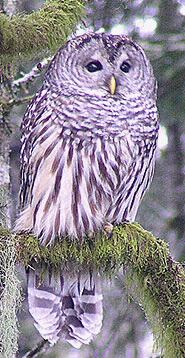
Classification
Domain: Eukarya

The Barred Owl is classified as a Eukarya because it has a true
nucleus and possesses membrane-bound organelles.
Kingdom: Animalia
The kingdom Animalia consists of organisms that are
multicellular as well as heterotrophic. Multicellularity allows
for the development of organs and tissues while being
heterotrophic makes animals seek out food because they cannot
make it on their own.
Phylum: Chordata
Barred Owls belong to the phylum chordata because it possesses
the five unique traits of the phylum. Chordates have a notochord
and a dorsal nerve cord, pharyngeal pouches, an endostyle, and a
postanal tail. Along with these characteristics, chordates are
triploblastic with bilateral symmetry which allows for extreme
cephalization. They have segmented bodies with a true coelom,
and a complete digestive tract.
Subphylum Craniata:
This subphylum represents true vertebrates. True vertebrates
have backbones.

Class: Aves
The class of aves are the birds. Birds have wings and feathers,
which are modified epidermal scales and are endothermic
organisms. Their bones are light with many air cavities, which
allows flight. Aves have beaks that do no have teeth.
Reproduction is internal, amniotic eggs are laid, and offspring
is watched over by parents.
Order: Strigiforms
Strigiforms encompass all owls. The key characteristics of it is
nocturnal hunting which includes silent flight, eyes and ears
are towards the anterior portion of the body. Their bodies are
compact. “Strig” is plural for the latin word strix, which means
“owl.”
Family: Strigidae
The family strigidae are known as the typical owls. Owls in this
family have a round skull and facial disk, and large eye sockets
that are surrounded by feathers. The beak of strigids is
shorter and less elongated. The feet in this family consist of
smooth edges on claws and a longer third toe. The sternum of
strigids have four notches. Strig is plural for the latin word
strix, which means “owl.” To learn some interesting facts about
owls,
click here.
Genus: Strix
In Latin strix means owl. The Barred Owl is classified under
this genus because it is an earless owl. Owls of this genus are
classified for being large forest dwellers.
Species: Strix varia
In Latin varia means “various.” The Barred Owl’s scientific name
translates into a single diverse owl. The Barred Owl’s main
characteristic is represented in the name, it has brown bars
running vertically down its chest.
Phylogenetic Trees:
This phylogenetic tree allows one to see exactly where Strix varia is located in the three domains of life. This tree is based off of morphologies between the different groups of organisms. In this tree it separates off into the different general groups of organisms.

This phylogenetic tree shows the owls related to the Barred Owl. It is based on morphological data, and goes from Family, to Sub-family, to genus. This allows you to observe which genius of owl are closely related to the barred owl.
